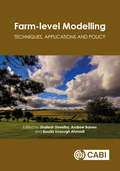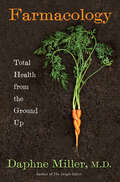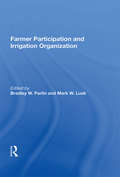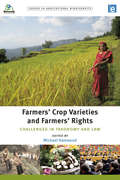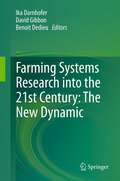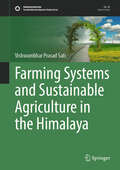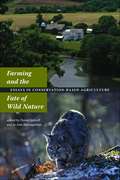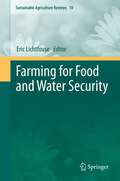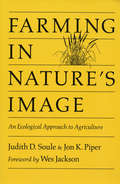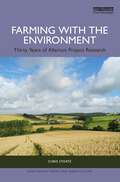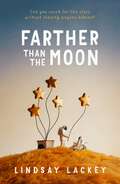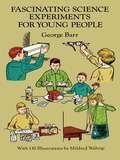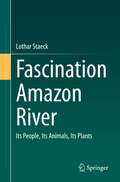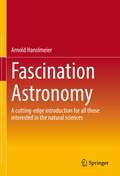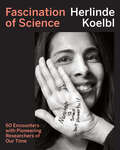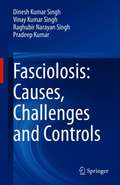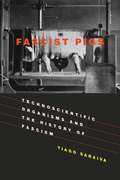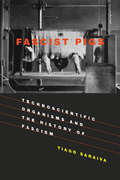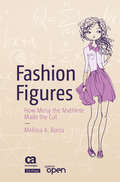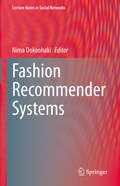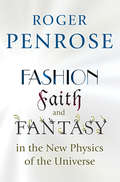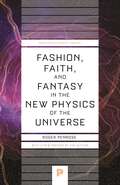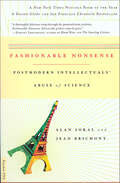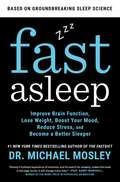- Table View
- List View
Farm-level Modelling: Techniques, Applications and Policy
by Paul Wilson Maria Espinosa Michael Michael David David Stephen Hynes Sergio Gomez y Paloma Patrick Abbot Maria Maria Arnaud Arnaud Stephen Stephen Filippo Arfini Michele Michele César Revoredo-Giha Cathal Cathal Pavel Pavel Bruce Bruce Wei Wei Wei Wei Thomas Thomas Roberto Solazzo Mario Veneziani Patrick Gillespie Fiona Thorne Thia Hennessy Vera Eory Jinxiu Ding Dr Weiwei Wang Eleonore Guillem Dave Murray-Rust Joana Guimarães Ferreira Alexander GochtAgriculture is the product of a complex mixture of behavioural, biophysical and market drivers. Understanding how these factors interact to produce crops and livestock for food has been the focus of economic investigation for many years. The advent of optimisation algorithms and the exponential growth in computing technology has allowed significant growth in mathematical modelling of the dynamics of agricultural systems. The complexity of approaches has grown in parallel with the availability of data at increasingly finer resolutions. Farm-level models have been widely used in agricultural economic studies to understand how farmers and land owners respond to market and policy levers. This book provides an in-depth description of different methodologies and techniques currently used in farm-level modelling. While giving an overview of the theoretical grounding behind the models, an applied approach is also used. Case studies range from the application of modelling to policy reforms and the subsequent impacts on rural communities and food supply. This book also provides descriptions of the use of farm-level models in much wider fields such as aggregation and linking with sectoral models. Its purpose is to show the reader the methods that have been employed to inform decision-makers about how to improve the economic, social and environmental goals required to achieve the aims of multidimensional policy.
Farmacology: Total Health from the Ground Up
by Daphne MillerWhat can good farming teach us about nurturing ourselves?In Farmacology, practicing family physician and renowned nutrition explorer Daphne Miller brings us beyond the simple concept of "food as medicine" and introduces us to the critical idea that it's the farm where that food is grown that offers us the real medicine.By venturing out of her clinic and spending time on seven family farms, Miller uncovers all the aspects of farming—from seed choice to soil management—that have a direct and powerful impact on our health. Bridging the traditional divide between agriculture and medicine, Miller shares lessons learned from inspiring farmers and biomedical researchers and weaves their insights and discoveries with stories from her patients. The result is a compelling new vision for sustainable healing and a treasure trove of farm-to-body lessons that have immense value in our daily lives.In Farmacology you will meet: a vegetable farmer in Washington state who shows us how the principles he uses to rejuvenate his soil apply just as well to our own bodies. a beef farmer in Missouri who shows how a holistic cattle-grazing method can grow resilient calves and resilient children. an egg farmer in Arkansas who introduces us to the counterintuitive idea that sometimes stresses can keep us productive and healthy. a vintner in Sonoma, California, who reveals the principles of Integrated Pest Management and helps us understand how this gentler approach to controlling unwanted bugs and weeds might be used to treat invasive cancers in humans. a farmer in the Bronx who shows us how a network of gardens offers health benefits that extend far beyond the nutrient value of the fruits and vegetables grown in the raised beds. an aromatic herb farmer back in Washington who teaches us about the secret chemical messages we exchange with plants that can affect our mood and even keep us looking youthful.In each chapter, Farmacology reveals the surprising ways the ecology of our bodies and the ecology of our farms are intimately linked. This is a paradigm-changing adventure that has huge implications for our personal health and the health of the planet.
Farmer Participation And Irrigation Organization
by Bradley W. ParlinThis book elaborates a perspective that can be used to democratize, decentralize, and privatize irrigation organizations. It uses case examples to illustrate the interrelationships between project performance, irrigation organization, and farmer participation.
Farmers' Crop Varieties and Farmers' Rights: Challenges in Taxonomy and Law (Issues in Agricultural Biodiversity)
by Michael HalewoodOver the last 50 years there has been a growing appreciation of the important role that farmers play in the development and conservation of crop genetic diversity, and the contribution of that diversity to agro-ecosystem resilience and food security. This book examines policies that aim to increase the share of benefits that farmers receive when others use the crop varieties that they have developed and managed, i.e., ‘farmers varieties’. In so doing, the book addresses two fundamental questions. The first question is ‘how do farmer management practices – along with other factors such as environment and the breeding systems of plants – affect the evolution and maintenance of discrete farmers’ varieties?’ The second question is ‘how can policies that depend on being able to identify discrete plant varieties accommodate the agricultural realities associated with the generation, use and maintenance of farmers’ varieties?’ This focus on discreteness is topical because there are no fixed, internationally recognized taxonomic or legal definitions of farmers’ varieties. And that presents a challenge when developing policies that involve making specific, discrete farmers’ varieties the subject of legal rights or privileges. The book includes contributions from a wide range of experts including agronomists, anthropologists, geneticists, biologists, plant breeders, lawyers, development practitioners, activists and farmers. It includes case studies from Asia, Africa, Latin America and Europe where, in response to a diversity of contributing factors, there have been efforts to develop policies that provide incentives or rewards to farmers as stewards of farmers’ varieties in ways that are sensitive to the cultural, taxonomic and legal complexities involved. The book situates these initiatives in the context of the evolving discourse and definition of ‘farmers' rights’, presenting insights for future policy initiatives.
Farming Systems Research into the 21st Century: The New Dynamic
by Ika Darnhofer Benoît Dedieu David GibbonFarming Systems Research has three core characteristics: it builds on systems thinking, it depends on the close collaboration between social and biophysical sciences, and it relies on participation to build co-learning processes. Farming Systems Research posits that to contribute towards sustainable rural development, both interdisciplinary collaborations and local actor engagement are needed. Together, they allow for changes in understanding and changes in practices. This book gives an overview of the insights generated in 20 years of Farming Systems Research. It retraces the emergence and development of Farming Systems Research in Europe, summarises the state-of-the-art for key areas, and provides an outlook on new explorations, especially those tackling the dynamic nature of farming systems and their interaction with the natural environment and the context of action.
Farming Systems and Sustainable Agriculture in the Himalaya (Sustainable Development Goals Series)
by Vishwambhar Prasad SatiThe farming system in the Central Himalayan Region is distinctive and unique, mainly focusing on the cultivation of traditional subsistence cereal crops. The agrobiodiversity in this region is rich, with the Central Himalaya growing numerous cultivars and crop races. The practice of cultivating many crops or cultivars in a single field is known as the 'Barahnaja System.' Another peculiar system is the Sar/Sari system, where different crops grow in the two Sars during the same seasons, with one Sar left fallow for six months while the other grows crops. This century-old farming method involves plowing fields with oxen and using organic manure to enhance crop production and productivity. However, recent changes have been observed in the farming systems. The area under traditionally growing millets is declining. In river valleys and middle altitudes, there is a recent trend towards cultivating paddy and wheat. Unfortunately, the cultivation of temperate fruits – apple and citrus has seen a decline in terms of area, production, and productivity. Various factors are influ encing farming systems in the Central Himalaya, such as high climate variability and change, decreasing crop production and productivity, evolving food habits, and out-migration. The book contains 12 chapters illustrating introduction, land use and land cover change, cropping patterns, crop diversity and agro-ecological zones, farming systems and sustainable agriculture, climate change and its impact on agriculture, infrastructural facilities for sustainable agriculture, declining agriculture: a case study, crop productivity and suitability analyzes, agribusiness, policies and planning for sustainable agriculture, and conclusions. It serves as a valuable resource for students, academicians, researchers, policymakers, and farmers.
Farming and the Fate of Wild Nature
by Daniel Imhoff Jo Ann BaumgartnerFarming and the Fate of Wild Nature addresses an urgent and complex issue facing communities and cultures throughout the world: the need for heightened land stewardship and conservation in an era of diminishing natural resources. Agricultural lands in rural areas are being purchased for development. Water scarcities are pitting urban and development expansion against agriculture and conservation needs. The farming population is ageing and retiring, while those who remain struggle against low commodity prices, international competition, rising production costs, and the threat of disappearing subsidies. We are living amidst a major extinction crisis--much of it driven by agriculture--as well as an increasing shift toward a global urban populace. The modern diet, driven by a grain-fed livestock industry, is no longer connected with the ecosystems that support it. In international circles, experts are arguing that further intensification of agriculture (through industrialization and genetic modification) will be necessary to both feed an exploding human population and to save what is left of wild biodiversity.This book takes up where its predecessor, the award-winning Farming with the Wild, left off. Featuring a wide range of in-depth essays, articles, and other materials by such authors as Aldo Leopold, Wendell Berry, Michael Pollan, Fred Kirschenmann, and Daniel Imhoff, this book persuasively demonstrates that farm and ranch operations which coexist with wild nature are necessary to sustain biodiversity and beauty on the landscape. In fact, as this invaluable educational resource demonstrates, they are essential in the challenge of building sane, healthy, and hopeful human societies.
Farming and the Fate of Wild Nature
by Daniel Imhoff Jo Ann BaumgartnerFarming and the Fate of Wild Nature addresses an urgent and complex issue facing communities and cultures throughout the world: the need for heightened land stewardship and conservation in an era of diminishing natural resources. Agricultural lands in rural areas are being purchased for development. Water scarcities are pitting urban and development expansion against agriculture and conservation needs. The farming population is ageing and retiring, while those who remain struggle against low commodity prices, international competition, rising production costs, and the threat of disappearing subsidies. We are living amidst a major extinction crisis--much of it driven by agriculture--as well as an increasing shift toward a global urban populace. The modern diet, driven by a grain-fed livestock industry, is no longer connected with the ecosystems that support it. In international circles, experts are arguing that further intensification of agriculture (through industrialization and genetic modification) will be necessary to both feed an exploding human population and to save what is left of wild biodiversity.This book takes up where its predecessor, the award-winning Farming with the Wild, left off. Featuring a wide range of in-depth essays, articles, and other materials by such authors as Aldo Leopold, Wendell Berry, Michael Pollan, Fred Kirschenmann, and Daniel Imhoff, this book persuasively demonstrates that farm and ranch operations which coexist with wild nature are necessary to sustain biodiversity and beauty on the landscape. In fact, as this invaluable educational resource demonstrates, they are essential in the challenge of building sane, healthy, and hopeful human societies.
Farming for Food and Water Security
by Eric LichtfouseSustainable agriculture is a rapidly growing field aiming at producing food and energy in a sustainable way for our children. This discipline addresses current issues such as climate change, increasing food and fuel prices, starvation, obesity, water pollution, soil erosion, fertility loss, pest control and biodiversity depletion. Novel solutions are proposed based on integrated knowledge from agronomy, soil science, molecular biology, chemistry, toxicology, ecology, economy, philosophy and social sciences. As actual society issues are now intertwined, sustainable agriculture will bring solutions to build a safer world. This book series analyzes current agricultural issues and proposes alternative solutions, consequently helping all scientists, decision-makers, professors, farmers and politicians wishing to build safe agriculture, energy and food systems for future generations.
Farming in Nature's Image: An Ecological Approach To Agriculture
by Wes Jackson Jon Piper Judy SouleFarming in Nature's Image provides, for the first time, a detailed look into the pioneering work of The Land Institute, the leading educational and research organization for sustainable agriculture.The authors draw on case studies, hands-on experience, and research results to explain the applications of a new system of agriculture based on one unifying concept: that farms should mimic the ecosystems in which they exist. They present both theoretical and practical information, including: a review of the environmental degradation resulting from current farming practices a critical evaluation of the attempts to solve these problems a detailed description of the ecosystem perspective and the proposed new agricultural system a case study illustrating how this new system could be applied to temperate grain production using perennial seed crops and the prairie as a model an examination of the potential savings in energy and water use, as well as potential contributions to ecological experiments and yield analysis work from The Land Institute.Written in clear, non-technical language, this book will be of great interest to soil and agricultural scientists, academics, policymakers, environmentalists, and other concerned with finding long-range solutions to agricultural problems.
Farming with the Environment: Thirty Years of Allerton Project Research (Earthscan Food and Agriculture)
by Chris StoateThis book examines, discusses and shares over 30 years’ worth of research from the Allerton Project, a research and demonstration farm in the UK which has been carrying out applied interdisciplinary research to explore and explain the need to adapt the management of farmland for environmental protection and to provide public benefits. Designed to provide guidance, feedback and recommendations to farmers, practitioners and policymakers, the Allerton Project is an exceptionally well-documented case study of lowland agricultural land management which has the purpose of meeting multiple objectives. This book draws on the wealth of knowledge built over the past 30 years and unveils and clarifies the complexity of a number of topical debates about current land and wildlife management at a range of spatial scales, explores the underlying historical context and provides some important pointers to future directions of travel. Topics include soil health and management, farmland ecology, development of management practices to enhance biodiversity, natural flood management, water quality and aquatic ecology. Most importantly, the book demonstrates how the findings from this project relate to agricultural and conservation policy more broadly as well as how they are applicable to similar projects throughout Europe. This book will be of great interest to professionals working in agricultural land management and conservation, as well as researchers and students of agri-environmental studies and agricultural policy.
Farther Than the Moon
by Lindsay LackeyFrom award-winning author Lindsay Lackey comes Farther Than the Moon, a heartfelt story about a boy who wants to become an astronaut, but wonders if his dreams can include his brother with disabilities, perfect for fans of We Dream of Space and Song for a Whale.All thirteen-year-old Houston Stewart has ever wanted is to become an astronaut. His dreams feel like they're finally coming true when he's accepted to the highly-competitive Junior Astronaut Recruitment Program – if only he could bring his little brother, Robbie, with him.Ever since their dad left, Houston and Robbie have been inseparable. It's hard to tell where Houston's love of space ends and where Robbie's begins. But Robbie's cerebral palsy and epilepsy mean he needs medical attention at home, so Houston must take this giant leap for the two of them all on his own.At camp, Houston is quickly drawn into the orbit of new friends, cosmic adventures, and a long-lost grandfather. But as Houston struggles to meet the program's rigorous demands, he’s forced to reckon with the truth that Robbie may never be able to visit space like the brothers have always hoped. But Houston is determined to honor Robbie’s dream, even if it seems like an impossible mission. So, like a good astronaut, he dares to make a new plan — one that shoots for the stars.Called "a remarkable and heartfelt story that is as fun and gripping as it is profoundly moving" by #1 New York Times-bestselling author Dan Gemeinhart, this is a captivating read for aspiring astronauts and scientists, and a perfect holiday gift.
Fascinating Science Experiments for Young People (Dover Children's Science Books)
by George BarrThis simply written introduction to scientific research and experimentation takes youngsters into an exciting world where they'll not only learn to discover their own answers to specific problems but will be encouraged to develop sound scientific attitudes and techniques as well.For this volume, noted science educator George Barr has compiled a carefully selected array of intriguing experiments dealing with chemistry, astronomy, magnetism and electricity, weather, water, the human body, living things, sound and light, and measurement. By performing these experiments, young researchers will discover the answers to such questions as "Why Can't We See Stars in the Daytime?" "How Can a Spider Web be Collected?" "Can Water Containing Ice Get Warm?" "How Can We See Sound Vibrations?" "What Helps Your Memory?" and many others.As the author early points out, the work is "not a reading book, but rather a doing book" with a chapter containing suggestions for further experiments. Valuable advice about scientific procedures emphasize the importance of taking readable, organized notes; gathering as much evidence as possible; learning to use "control" groups; and much more. In addition, over 100 illustrations enhance the text, which also contains a selected bibliography of relevant reading material.
Fascination Amazon River: Its People, Its Animals, Its Plants
by Lothar StaeckIn this volume, the Amazon and its adjacent rainforest are presented in all their important facets: First, there is the vast river system itself, with its network of white, black, and clear water rivers. The different water qualities have an enormous impact on people, animals and plants. On the other hand, the people who live along this "Rio Mar," the ocean river, are described. They are the Caboclos, the descendants of the European immigrants and the indigenous people, and it is the different indigenous peoples who have mostly settled along the riverbanks, since the rivers here replace the roads and make contact with other people possible in the first place. Although these ethnic groups have been in contact with Western civilization for generations,they have surprisingly preserved a number of remarkable traditions that are described here. The treasure of the Amazon is its plants and animals. Therefore, the most fascinating flowering plants, including numerous medicinal plants, trees, epiphytes and lianas from different habitats are described in detail and illustrated with excellent photographs. Finally, it is the animals, especially in and around the river, that have always fascinated Alexander von Humboldt. Not only is the lifestyle of the legendary pink dolphins, piranhas and tarantulas explained here, but the impressive amphibians, reptiles and mammals of the jungle are also discussed.epiphytes and lianas from different habitats are described in detail and illustrated with excellent photographs. Finally, it is the animals, especially in and around the river, that have always fascinated Alexander von Humboldt. Not only is the lifestyle of the legendary pink dolphins, piranhas and tarantulas explained here, but the impressive amphibians, reptiles and mammals of the jungle are also discussed.epiphytes and lianas from different habitats are described in detail and illustrated with excellent photographs. Finally, it is the animals, especially in and around the river, that have always fascinated Alexander von Humboldt. Not only is the lifestyle of the legendary pink dolphins, piranhas and tarantulas explained here, but the impressive amphibians, reptiles and mammals of the jungle are also discussed.This book is a translation of the original German 1st edition Faszination Amazonas by Lothar Staeck, published by Springer-Verlag GmbH Germany, part of Springer Nature in 2019. The translation was done with the help of artificial intelligence (machine translation by the service DeepL.com). A subsequent human revision was done primarily in terms of content, so that the book will read stylistically differently from a conventional translation. Springer Nature works continuously to further the development of tools for the production of books and on the related technologies to support the authors.
Fascination Astronomy: A cutting-edge introduction for all those interested in the natural sciences
by Arnold HanslmeierIn this work, Prof. Arnold Hanslmeier provides modern and fascinating astronomical knowledge. The book begins with a description of the origin of the universe and goes on to dark matter, black holes and the formation of the solar system. Finally, it is rounded off at the end by the exciting question: Are we alone in the universe?In this book, which originated from a lecture given at the University of Graz for students of all faculties, the author explains the interrelationships clearly and in a generally understandable way with the help of many colourful pictures, without demanding too much basic knowledge of mathematics and physics. Somewhat deeper formulas and text passages are separated from the rest of the text and can be skipped without losing the context.This third edition incorporates new findings such as the spectacular direct discovery of gravitational waves, fascinating images and data from Pluto, and the first landing on a comet. Numerous new photographs and illustrations have been added to aid understanding. The latest data in the field of exoplanet research has also been incorporated.The book is intended not only for students, but also for interested laymen as well as for all those who deal with modern findings of natural science."Physics, especially astrophysics, can be extremely exciting, I hope my readers gain just that impression by reading this book!" A. Hanslmeier
Fascination of Science: 60 Encounters with Pioneering Researchers of Our Time
by Herlinde KoelblAn intimate collection of portraits of internationally renowned scientists and Nobel Prize winners, paired with interviews and personal stories.What makes a brilliant scientist? Who are the people behind the greatest discoveries of our time? Connecting art and science, photographer Herlinde Koelbl seeks the answers in this English translation of the German book Fascination of Science, an indelible collection of portraits of and interviews with sixty pioneering scientists of the twenty-first century. Koelbl&’s approach is intimate and accessible, and her highly personal interviews with her subjects reveal the forces (as well as the personal quirks) that motivate the scientists&’ work; for example, one wakes up at 3 am because her mind is calm then, another says his best ideas come to him in the shower. These glimpses into the scientists&’ lives and thinking add untold texture in this up-to-the-minute survey of the activities and progress that are currently taking place in the broad field of the natural sciences.Koelbl&’s interview subjects include Nobel Prize winners Dan Shechtman, Frances Arnold, Carolyn Bertozzi, and cover scientific fields from astronomy, biochemistry, and quantum physics to stem-cell research and AI. Beautifully bringing together art, science, and the written word, Fascination of Science is an inspiring read that shows how creativity, obsession, persistence, and passion drive the pioneering researchers of our time.
Fasciolosis: Causes, Challenges and Controls
by Pradeep Kumar Dinesh Kumar Singh Vinay Kumar Singh Raghubir Narayan SinghThis book provides an up-to-date review of fasciolosis, a disease caused by Fasciola hepatica and Fasciola gigantica, including its biology, transmission, epidemiology, host distribution, economic impact, and novel approaches for its diagnosis, treatment and prevention.It first offers a brief overview of the history of the disease, the genetic diversity of the parasite and its distribution, and the ecology of the vector snail, which belongs to the Lymnaeidae/Planorbidae family. It also examines the current strategies and novel approaches for controlling the parasite, diagnosing infections and vaccine development.Importantly, it highlights issues relating to the control of fasciolosis, including drug resistance, lack of effective diagnostics, and the parasite’s long-term survival strategies based on regulation and modulation of the host immune system. Lastly, it discusses the novel control snail vectors using bait formulations, and synergetic and phototherapy treatment with chlorophyllin, which does not kill the vector.
Fascist Pigs: Technoscientific Organisms and the History of Fascism
by Tiago SaraivaIn the fascist regimes of Mussolini's Italy, Salazar's Portugal, and Hitler's Germany, the first mass mobilizations involved wheat engineered to take advantage of chemical fertilizers, potatoes resistant to late blight, and pigs that thrived on national produce. Food independence was an early goal of fascism; indeed, as Tiago Saraiva writes in Fascist Pigs, fascists were obsessed with projects to feed the national body from the national soil. Saraiva shows how such technoscientific organisms as specially bred wheat and pigs became important elements in the institutionalization and expansion of fascist regimes. The pigs, the potatoes, and the wheat embodied fascism. In Nazi Germany, only plants and animals conforming to the new national standards would be allowed to reproduce. Pigs that didn't efficiently convert German-grown potatoes into pork and lard were eliminated.Saraiva describes national campaigns that intertwined the work of geneticists with new state bureaucracies; discusses fascist empires, considering forced labor on coffee, rubber, and cotton in Ethiopia, Mozambique, and Eastern Europe; and explores fascist genocides, following Karakul sheep from a laboratory in Germany to Eastern Europe, Libya, Ethiopia, and Angola.Saraiva's highly original account -- the first systematic study of the relation between science and fascism -- argues that the "back to the land" aspect of fascism should be understood as a modernist experiment involving geneticists and their organisms, mass propaganda, overgrown bureaucracy, and violent colonialism.
Fascist Pigs: Technoscientific Organisms and the History of Fascism (Inside Technology)
by Tiago SaraivaHow the breeding of new animals and plants was central to fascist regimes in Italy, Portugal, and Germany and to their imperial expansion. In the fascist regimes of Mussolini's Italy, Salazar's Portugal, and Hitler's Germany, the first mass mobilizations involved wheat engineered to take advantage of chemical fertilizers, potatoes resistant to late blight, and pigs that thrived on national produce. Food independence was an early goal of fascism; indeed, as Tiago Saraiva writes in Fascist Pigs, fascists were obsessed with projects to feed the national body from the national soil. Saraiva shows how such technoscientific organisms as specially bred wheat and pigs became important elements in the institutionalization and expansion of fascist regimes. The pigs, the potatoes, and the wheat embodied fascism. In Nazi Germany, only plants and animals conforming to the new national standards would be allowed to reproduce. Pigs that didn't efficiently convert German-grown potatoes into pork and lard were eliminated.Saraiva describes national campaigns that intertwined the work of geneticists with new state bureaucracies; discusses fascist empires, considering forced labor on coffee, rubber, and cotton in Ethiopia, Mozambique, and Eastern Europe; and explores fascist genocides, following Karakul sheep from a laboratory in Germany to Eastern Europe, Libya, Ethiopia, and Angola. Saraiva's highly original account—the first systematic study of the relation between science and fascism—argues that the “back to the land” aspect of fascism should be understood as a modernist experiment involving geneticists and their organisms, mass propaganda, overgrown bureaucracy, and violent colonialism.
Fashion Figures
by Melissa A. BorzaMissy Maker is a middle school girl who loves math and fashion. She sees math in everything she does. She tries to hide this from her friends, because she thinks it's too geeky. Missy hears that the school math club needs more members, but she's worried about what her friends will think if she joins, and she's already committed to joining the fashion club. After an epic internal struggle and with the support of her peers and her quirky, loving family, Missy finds that she can be both a Mathlete and a Fashionista. Missy figures out how to bring the two clubs together to help both groups win. In the process, she discovers that she can openly excel in math and science and still be popular with her peers. She also learns how her math and science skills can help her artistic endeavors. Gain an inside perspective on what it's like when you love math and science and happen to be a girl. Fashion Figures highlights the societal and internal pressures preteen and early-teen girls often face when they excel in these subjects, and it shows strategies for overcoming barriers to being themselves and doing what they love while still fitting in socially. What You'll Learn Girls can have a passion for STEM (science, technology, engineering and math) subjects and still be cool Girls can be great at math Math skills are important in non-STEM centered subject areas like fashion and art Math can be fun Who This Book Is For Pre-teen and early-teen girls (9-14 years old)
Fashion Recommender Systems (Lecture Notes in Social Networks)
by Nima DokoohakiThis book includes the proceedings of the first workshop on Recommender Systems in Fashion 2019. It presents a state of the art view of the advancements within the field of recommendation systems with focused application to e-commerce, retail and fashion. The volume covers contributions from academic as well as industrial researchers active within this emerging new field.Recommender Systems are often used to solve different complex problems in this scenario, such as social fashion-based recommendations (outfits inspired by influencers), product recommendations, or size and fit recommendations. The impact of social networks and the influence that fashion influencers have on the choices people make for shopping is undeniable. For instance, many people use Instagram to learn about fashion trends from top influencers, which helps them to buy similar or even exact outfits from the tagged brands in the post. When traced, customers’ social behavior can be a very useful guide for online shopping websites, providing insights on the styles the customers are really interested in, and hence aiding the online shops in offering better recommendations and facilitating customers quest for outfits. Another well known difficulty with recommendation of similar items is the large quantities of clothing items which can be considered similar, but belong to different brands. Relying only on implicit customer behavioral data will not be sufficient in the coming future to distinguish between for recommendation that will lead to an item being purchased and kept, vs. a recommendation that might result in either the customer not following it, or eventually return the item. Finding the right size and fit for clothes is one of the major factors not only impacting customers purchase decision, but also their satisfaction from e-commerce fashion platforms. Moreover, fashion articles have important sizing variations. Finally, customer preferences towards perceived article size and fit for their body remain highly personal and subjective which influences the definition of the right size for each customer.The combination of the above factors leaves the customers alone to face a highly challenging problem of determining the right size and fit during their purchase journey, which in turn has resulted in having more than one third of apparel returns to be caused by not ordering the right article size. This challenge presents a huge opportunity for research in intelligent size and fit recommendation systems and machine learning solutions with direct impact on both customer satisfaction and business profitability.
Fashion, Faith, and Fantasy in the New Physics of the Universe
by Roger PenroseWhat can fashionable ideas, blind faith, or pure fantasy possibly have to do with the scientific quest to understand the universe? Surely, theoretical physicists are immune to mere trends, dogmatic beliefs, or flights of fancy? In fact, acclaimed physicist and bestselling author Roger Penrose argues that researchers working at the extreme frontiers of physics are just as susceptible to these forces as anyone else. In this provocative book, he argues that fashion, faith, and fantasy, while sometimes productive and even essential in physics, may be leading today's researchers astray in three of the field's most important areas--string theory, quantum mechanics, and cosmology.Arguing that string theory has veered away from physical reality by positing six extra hidden dimensions, Penrose cautions that the fashionable nature of a theory can cloud our judgment of its plausibility. In the case of quantum mechanics, its stunning success in explaining the atomic universe has led to an uncritical faith that it must also apply to reasonably massive objects, and Penrose responds by suggesting possible changes in quantum theory. Turning to cosmology, he argues that most of the current fantastical ideas about the origins of the universe cannot be true, but that an even wilder reality may lie behind them. Finally, Penrose describes how fashion, faith, and fantasy have ironically also shaped his own work, from twistor theory, a possible alternative to string theory that is beginning to acquire a fashionable status, to "conformal cyclic cosmology," an idea so fantastic that it could be called "conformal crazy cosmology."The result is an important critique of some of the most significant developments in physics today from one of its most eminent figures.
Fashion, Faith, and Fantasy in the New Physics of the Universe (Princeton Science Library)
by Roger PenroseNobel Prize–winning physicist Roger Penrose questions some of the most fashionable ideas in physics today, including string theoryWhat can fashionable ideas, blind faith, or pure fantasy possibly have to do with the scientific quest to understand the universe? Surely, theoretical physicists are immune to mere trends, dogmatic beliefs, or flights of fancy? In fact, acclaimed physicist and bestselling author Roger Penrose argues that researchers working at the extreme frontiers of physics are just as susceptible to these forces as anyone else. In this provocative book, he argues that fashion, faith, and fantasy, while sometimes productive and even essential in physics, may be leading today's researchers astray in three of the field's most important areas—string theory, quantum mechanics, and cosmology.Arguing that string theory has veered away from physical reality by positing six extra hidden dimensions, Penrose cautions that the fashionable nature of a theory can cloud our judgment of its plausibility. In the case of quantum mechanics, its stunning success in explaining the atomic universe has led to an uncritical faith that it must also apply to reasonably massive objects, and Penrose responds by suggesting possible changes in quantum theory. Turning to cosmology, he argues that most of the current fantastical ideas about the origins of the universe cannot be true, but that an even wilder reality may lie behind them. Finally, Penrose describes how fashion, faith, and fantasy have ironically also shaped his own work, from twistor theory, a possible alternative to string theory that is beginning to acquire a fashionable status, to "conformal cyclic cosmology," an idea so fantastic that it could be called "conformal crazy cosmology."The result is an important critique of some of the most significant developments in physics today from one of its most eminent figures.
Fashionable Nonsense: Postmodern Intellectuals' Abuse of Science
by Jean Bricmont Alan SokalIn 1996 physicist Alan Sokal published an essay in Social Text--an influential academic journal of cultural studies--touting the deep similarities between quantum gravitational theory and postmodern philosophy. Soon thereafter, the essay was revealed as a brilliant parody, a catalog of nonsense written in the cutting-edge but impenetrable lingo of postmodern theorists. The event sparked a furious debate in academic circles and made the headlines of newspapers in the U.S. and abroad.In Fashionable Nonsense: Postmodern Intellectuals' Abuse of Science, Sokal and his fellow physicist Jean Bricmont expand from where the hoax left off. In a delightfully witty and clear voice, the two thoughtfully and thoroughly dismantle the pseudo-scientific writings of some of the most fashionable French and American intellectuals. More generally, they challenge the widespread notion that scientific theories are mere "narrations" or social constructions.
Fast Asleep: Improve Brain Function, Lose Weight, Boost Your Mood, Reduce Stress, and Become a Better Sleeper
by Dr Dr Michael MosleyThe #1 New York Times bestselling author of The Clever Gut Diet and &“one of the world&’s leading journalists covering nutrition and health&” (Dr. Valter Longo, director of the University of Southern California Longevity Institute) presents a science-based sleep program designed to improve brain function, support weight loss, boost your mood, and reduce stress. Getting a good night&’s sleep is everyone&’s daily goal. After all, it reduces your risk of depression, helps you fight chronic disease, improves your memory, and it just plain feels good. Yes, but if sleep can give us all these things and more, why is it that so many of us struggle to get the necessary seven to eight hours a night? In Fast Asleep, Dr. Michael Mosley brings together the latest, groundbreaking science to explain exactly why it is so important that we regularly get enough sleep. Prone to insomnia, he has taken part in numerous sleep experiments and tested every sleep remedy. Combining personal insight and in-depth research, he explains why so many of us struggle with sleep, what works and what doesn&’t, and shares his own myth-busting program to help you achieve a good night&’s rest. Filled with fascinating case studies, fifty delicious, sleep-promoting recipes, and more Fast Asleep is a complete resource that offers a range of tools for combating fatigue and tiredness. Simple, effective, and life-changing, this book explores the science of dreaming, explains why gut health and meal times matter, and reveals tips and tricks to help you not just to sleep better, but to reduce stress levels and feel happier and healthier in general.
